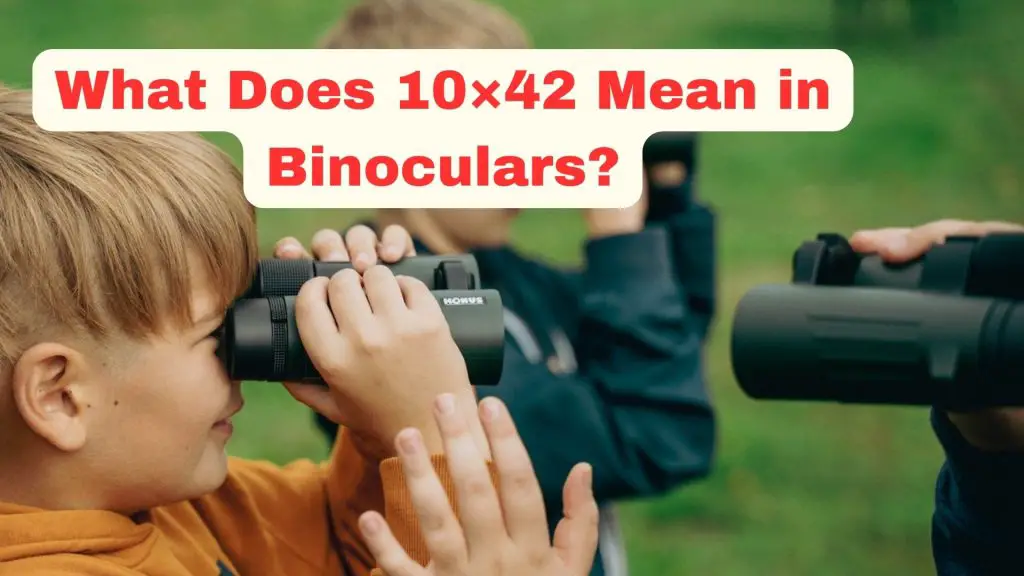What Does 10×42 Mean in Binoculars?
If you’re new to this fascinating field of optics, you may be wondering what all the numbers and letters on your binoculars mean.

And if you’re an experienced user, you might still have questions about what specifications to look for when purchasing a new pair.
In this article, we’re going to focus on one of the most common binocular specifications: 10×42.
We’ll explore what those numbers mean, how they impact the performance of your binoculars, and which activities these binoculars are best suited for.
By the end of this article, you’ll be a binocular expert and confidently guide your friends through the world of binoculars. So, let’s get started!
What Does 10×42 Mean
First Number i.e 10
The first number in the “10×42” description refers to the magnification of the binoculars.
In this case, “10” means that the object being viewed will appear ten times closer than it would with the naked eye.
This magnification is significant because it allows for detailed observation of distant objects, making it an ideal choice for activities such as bird watching, wildlife observation, and astronomy.
However, it’s important to note that higher magnification also means a narrower field of view and less stability, as even the slightest movement can cause a significant shift in the image being viewed.
Second Number i.e 42
The second number in the description, “42”, refers to the objective lens diameter, which is the diameter of the lens at the end of the binoculars farthest from your eyes.
The objective lens diameter determines how much light the binoculars can gather, which impacts the image’s brightness and clarity.
A larger objective lens diameter allows more light to enter the binoculars, resulting in brighter and clearer images.
In this case, 42mm is a relatively large objective lens diameter, making these binoculars ideal for low-light conditions such as early morning or late evening. However, the downside to larger objective lenses is that they tend to make the binoculars heavier and bulkier.
When compared to other magnification and objective lens diameter combinations, 10×42 binoculars offer a good balance of magnification and light-gathering capabilities.
For example, 8×42 binoculars provide a wider field of view and are generally easier to stabilize than 10×42 binoculars.
Check: 8×42 vs 10×42 Binoculars
On the other hand, 12×50 binoculars provide even greater magnification and light-gathering capabilities, but they tend to be bulkier and heavier than 10×42 binoculars.
Check:10×42 Vs 12×50 Binoculars
Pros & Cons Of 10×42 Binoculars
Advantages of 10×42 binoculars
One of the most significant advantages of 10×42 binoculars is their increased magnification, which allows for detailed observation of distant objects.
This makes them ideal for activities such as bird watching, wildlife observation, and astronomy.
Additionally, the 42mm objective lens diameter provides excellent light-gathering capabilities, making these binoculars ideal for low-light conditions such as early morning or late evening.
The increased magnification and light-gathering capabilities of 10×42 binoculars result in brighter and clearer images than those with smaller objective lens diameters.
Disadvantages of 10×42 binoculars
One of the main drawbacks of 10×42 binoculars is their increased weight and bulkiness.
The larger objective lens diameter means that the binoculars will be heavier, making them more challenging to hold steady for extended periods.
Additionally, the increased magnification of 10×42 binoculars results in a narrower field of view, making it more challenging to locate objects quickly.
This can be a significant disadvantage for activities such as bird watching or wildlife observation, where objects may move quickly or be difficult to spot.
Comparison of 8x Binoculars With 10x Binoculars
When it comes to binoculars, an 8x magnification is sometimes preferred over a 10x or higher magnification for several reasons. Firstly, an 8x binocular provides a wider field of view, larger exit pupil, and longer eye relief, making it easier to spot and track moving objects. This makes it an ideal choice for hunting in thicker forest areas where you need a wider view of your surroundings.
In addition to its wider field of view, the 8x binocular also offers maximum light-gathering capability, making it an excellent option for low-light conditions. It allows more light to enter the binoculars, resulting in brighter and clearer images, even in dimly lit environments.
Another advantage of using an 8x or lower magnification binocular is the steadier image it provides. When using binoculars for extended periods, even slight movements from hand or wind can cause shaking and affect image quality. However, with lower-magnification binoculars, the impact of these slight movements is less noticeable, resulting in a steadier image.
How Far Can I See With 10×42 Binoculars?
The question of “How far can binoculars see” is actually a bit of a misnomer, and here’s why.
Essentially, there is no specific limit to how far away you can see something. For instance, you can view the Moon or Sun or even Andromeda Galaxy with your binoculars even though it’s approximately 2.537 million light-years away. However, the image you see will likely be blurred and indistinct.
Now, what is important is the level of detail you can make out in that object from a distance.
So, To get a clearer and more detailed view of such faraway objects, you need binoculars that can magnify them. Therefore, the main point to consider is the magnification capability of the binocular rather than the distance you can see.
In a Nutshell, Binoculars are designed to magnify whatever you’re looking at, be it a bird on a tree branch or a distant mountain range. The distance to the object you’re viewing is less important than the level of magnification you’re using.
For instance, let’s say you’re trying to spot a bird that’s perched on a tree branch 100 feet away. With a set of binoculars with 10x magnification, you can zoom in on the bird and make it appear as if it’s only 10 feet away. Similarly, if you’re trying to view a mountain range that’s 10 miles away, you can use binoculars to bring the mountains closer and make them appear as if they’re only one miles away.
It’s important to note, however, that the level of magnification you use can also impact the clarity and detail of the image you see. For example, if you’re using a high-powered magnification on a distant object, you may notice that the image becomes shaky or blurry due to slight movements of your hands or wind.
In short, the distance that binoculars can “see” is really only limited by the level of magnification you choose. So, whether you’re trying to spot a bird in a nearby tree or take in the sweeping vistas of a distant mountain range, the right set of binoculars can help you get a closer look.
Check Our Detailed Take: How Far Can I See With Binoculars
Price of 10×42 Binoculars
The price of 10×42 binoculars can vary greatly depending on the brand, quality, and features.
You can find budget options for as low as $50, while higher-end models can cost several thousand dollars.
On average, a good quality pair of 10×42 binoculars can be purchased for around $200 to $500.
It’s important to consider your intended use and personal preferences when choosing binoculars, as paying a higher price does not always guarantee better performance.
Check Binoculars In Your Budget:
Best Binoculars Under $300 & 400
Best Binoculars Under 500 & 600 Dollar – Top 6 Picks Of 2023
What Are 10×42 Binoculars Best For?

Hunting:
10×42 binoculars are a good choice for hunting, especially in open fields or for long-range scouting. In fact, some of the best binoculars for hunting featured are with 10x magnification.
The 10x magnification allows for a more detailed view of the target, while the 42mm objective lens diameter provides good light-gathering capability for use in low-light conditions.
Birdwatching:
10×42 binoculars are a popular choice among birdwatchers, as they provide a good balance between magnification and light-gathering capability. The 10x magnification is sufficient for identifying birds at a distance, and the 42mm objective lens diameter provides a bright and clear image.
However, 8x is the best preferred since the larger magnification of 10x can make it harder to locate birds in the first place, and the narrower field of view might be a disadvantage in some situations.
Read Some Of Our 10×42 Binoculars Comprehensive Review:
Zeiss Conquest HD 10×42 Review,
Zeiss Victory SF 10×42 Review-Field Tested!,
Athlon Argos Binoculars 10X42 Review
Swarovski Optik NL Pure 10×42 Binocular Review
Whale Watching
10×42 binoculars can be a good choice for whale watching, as they provide a good balance between magnification and light-gathering capability. With 10x magnification, you’ll be able to bring distant whales closer and observe their behavior and details more clearly.
The 42mm objective lens diameter also provides good light-gathering capabilities, which can be especially helpful when whale watching in low light conditions such as an early morning or late afternoon.
However, keep in mind that 10x magnification may also result in a narrower field of view, which can make it more challenging to track fast-moving whales.
So you can check more picks and choices here-Best Binoculars for Whale Watching
Safari:
10×42 binoculars are also a great choice for safari trips, where you need to view animals from a distance.
The 10x magnification allows for good detail at longer distances, while the 42mm objective lens diameter provides good light gathering capability for use during dawn and dusk hours.
Read: 12 Best Binoculars for Safari in the Market – 2023 Reviews & Guide
Here Is An Interesting Video Of A 10×42 Binocular Popular Model
Conclusion
In conclusion, we hope this article has shed some light on what 10×42 means in binoculars and how it impacts their performance. We’ve explained the benefits and drawbacks of 10×42 binoculars and provided guidance on which activities they are best suited for.
Remember, choosing the right pair of binoculars can greatly enhance your outdoor experience, whether you’re birdwatching, hunting, or simply enjoying the beauty of nature. Understanding binoculars specifications such as magnification and aperture is key to making an informed decision.
We hope this guide has helped simplify the process for you, and that you now feel more confident in choosing the perfect pair of binoculars for your needs. Happy exploring!
